
Spuria iris
The Spuria iris belong to sub-genus Xyridion. The characteristic features of them are droplets of nectar on the outer walls of the tube under the flower, swallen parchment-like seed coat, and seed pods having a long rostellum and 6 well-defined protruding ribs brought together in pairs.

77. 'Color Carnival'
The iris of this sub-genus grow predominantly in arid steppe and sometimes in semi-desert regions of Asia, Europe and North Africa. Of 20 species described, 14 occur in the USSR (10 of them growing wild).
The wild species should deserve special attention of iris growers and breeders as they are the source of useful properties for hybridization such as heat-, salt- and cold-resistance. Digging-out of the rhizomes of wild iris is strictly prohibited, only seeds can be used (besides, they give more reliable results).
In the foreign floricultural literature, the name Spuria extends to all species and cultivars of this large group of iris by the main species of the group, Iris spuria, widely distributed in Western Europe. It bears large violet flowers on nearly one-meter stalks.
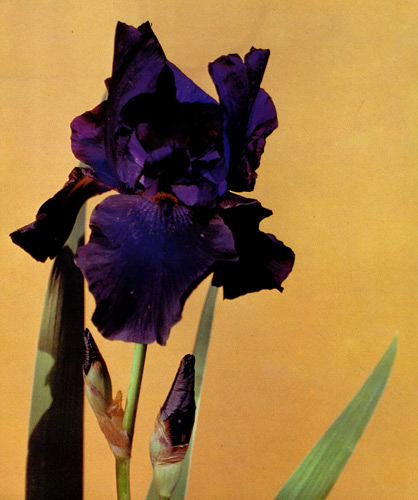
78. 'Black Taffeta'
In the flora of the USSR Iris spuria is replaced by Iris karthaliniae and I. klattii (syn. I. violaceae, I. musulmanica). The most typical forms of I. karthaliniae are found in bottomland, wet meadows of the middle and upper Kura River and of its tributaries. The second species is also associated with flat lands with abundant supply of moisture, but its range is greater and includes Dagestan, southern and eastern Transcaucasia and northern Iran.

79. 'Wild Ginger'
In Leningrad latitude the two species overwinter unprotected. They develop vigorous clumps. Iris karthaliniae has narrower foliage (10 to 15mm) and flowers of less intensive colouring.
Iris halophyla has a wide distributional range. It was common in the steppe areas of the European part of the USSR, western Siberia and Kazakhstan. This species with lovely golden-yellow flowers is found in Moldavia.
In Central Asia and Kazakhstan occurs Iris sogdiana, which differs from the previous species by violet-bluish flowers and shorter crests.
Two more Spuria species grow in the Caucasus which are of interest to iris breeders, Iris notha, found in the hills in the Stavropol Territory, and I. demetrii Akch. et. Mirz. (syn. I. prilipcoana Kern-Nat) occurring in the mountaneous Armenia and Azerbaijan. They differ from other species of the group both ecologically (they prefer dry slopes, on wet grounds they die down) and genetically as only 38 chromosomes are contained in their cell nuclei compared with 44 in I. klattii, I. karthaliniae and I. halophyla.
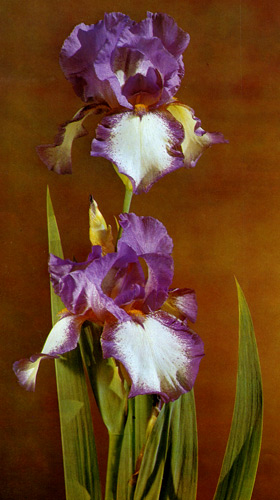
80. 'Kitize'
Some traits of I. notha and I. demetrii such as peculiarities of the spathes remain unused so far. The majority of Spuria cultivars have swollen spathes which spoils the flower. The two "xerophylous" species are free from this shortcoming. Dark-green, compact, nicely shaped spathes add to the beauty of the flowers. The flower stem itself is stiff and beautiful. The flowers of pure bluish shades are lovely.
Iris graminea with dark-green foliage and Iris humilis occurring in the Caucasus and south-western Ukraine are good for growing in rock gardens. Tender bluish or purple-violet flowers of I. humilis appear just above soil surface and the foliage is only 0.5 to 0.6 cm wide.
Fine foliage is a feature of Iris sintenisii. Its light violet flowers set low in the foliage are splendid. This species brought from Asia Minor has happily acclimatized in the Stavropol Botanical Garden.

81. 'Bazaar'
Among the wild species belonging to the subgenus Xyridion, no red-flowered species is known, while yellow ones are predominant. Of real old gold are the flowers of Iris crocea (syn. I. aurea). This "southerner" is warm-requiring. It was successfully grown in the Botanical Garden in Ashkhabad. There L. E. Soboleva have succeded in building up a fairly rich collection both of species and foreign cultivars of Spuria iris.
To tall yellow-flowered spurias belongs also Iris ohroleuca which has been well acclimatized in the USSR. This species originates in steppe regions of Turkey. In the twilight its flowers on tall stems seen from a distance are like butterflies hovering over the leafage.
Close to Iris ohroleuca is I. monnieri, also coming from Asia Minor. It grows in the Nikita State Botanical Garden and in some gardens in Yalta. In Leningrad latitude it overwinters without any protection.

82. 'May Delight'
In western Europe and the USA Spuria iris have been used in ornamental horticulture quite recently. In the 1930s and 1940s I. spuria and Iris ohroleuca were hybridized by several members of the American Iris Society which later set up the Spuria Iris Society. The development of a series of golden-yellow hybrids was a success. 'Wadi-Zem-Zem' is especially interesting. It has contributed to a strain of highly virus-resistant cultivars.
The 1960s culminated in the development of Spuria cultivars with broad velvet petals of reddish-brown or dark-red tone ('Proverb', Conquista'). Top success of intensive hybridization and selection were sharply contrasting bicolour cultivars and cultivars with flowers resembling the orchids of the Kattlei genus in tender rosy-violet tone ('Clark Cosgrave'). One of recent bulletins of the Society lists already 315 cultivars.
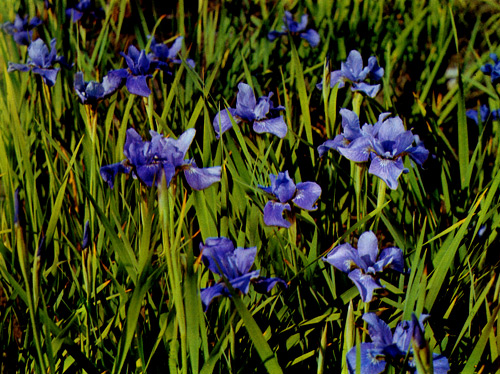
83. 'Sally Kerlin'
Most of the gardeners in the USSR are not familiar either with the assortment, JOT with cultural peculiarities of this promising iris group. The Guide presents the cultivar 'Lenkoran' (developed in the Leningrad Botanical Garden). This group allows us to extend the blooming season as Spurias bloom later than the beardeds.
Due to their biological peculiarities, the best time for division and replanting of the Spuria iris is late summer to early autumn. Unlike the bearded iris, Spurias do not like transplantation, but when established, and with proper care, they may grow in the same place for 7 to 9 or even 10 to 15 years, without losing their ornamental qualities.
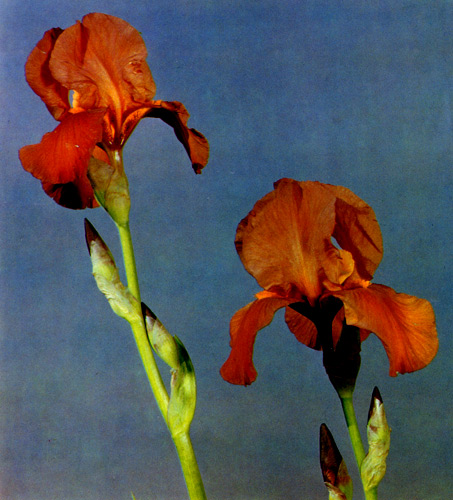
84. 'Brasilia'
They do well on neutral or mildly alkaline soils, prefer sunny situations and stand winds well. Frost-resistance needs further study, but many of them overwinter unpotected in Leingrad latitude, which is accounted for by the ability of the rhizomes to dig into the soil. Seeds sown in late autumn show good germination, and the seedlings start flowering the second or third year.
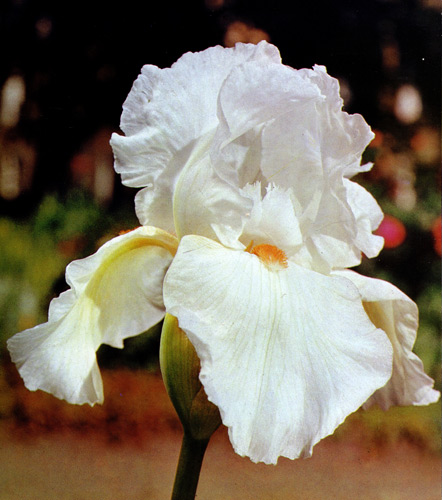
85. 'Brilliant Star'
The cultivars are highly heat-tolerant, and some of them salt-tolerant. For this reason, they seem primising for southern regions of the USSR. In arid zones they need watering during the growing season or require soils with high water table. The exceptions are Iris notha, Iris demetrii and Iris sintenisii which negatively respond to excessive moisture. In the open ground they can replace xiphiums known as Holland, Spanish and English irises.
In the post-war time extensive studies of the species of the Xyridion sub-genus and partially of cultivars of the Spuria group were carried out in the botanical gardens of Leningrad (G. I. Rodionenko), Ashkhabad (L. E. Soboleva), Kishinev (N. L. Sharova) and in Erevan (A. A. Akhverdov and N. N. Mirzoeva).
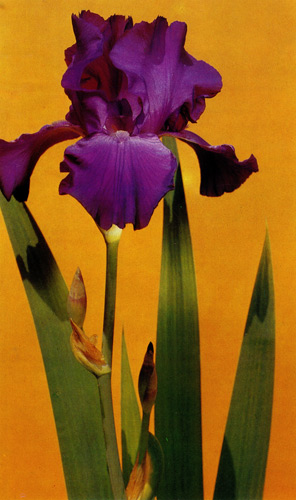
86. 'Jersey Beauty'
|
ПОИСК:
|
© FLOWERLIB.RU 2001–2022
При использовании материалов активная ссылка обязательна:
http://flowerlib.ru/ 'Библиотека по цветоводству'
При использовании материалов активная ссылка обязательна:
http://flowerlib.ru/ 'Библиотека по цветоводству'